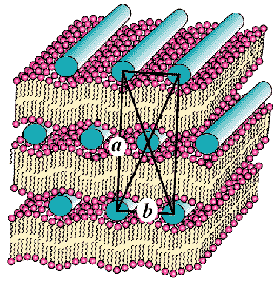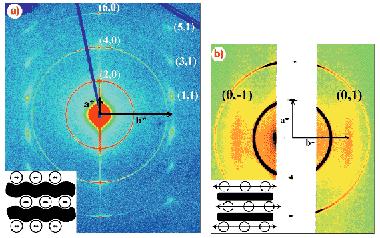- Home
- Users & Science
- Scientific Documentation
- ESRF Highlights
- ESRF Highlights 2000
- Soft Condensed Matter
- Sliding Columnar Phase in DNA-Membrane Complexes
Sliding Columnar Phase in DNA-Membrane Complexes
In low-dimensional soft matter systems, the conventional long-range order is often destroyed by thermal fluctuations - the so-called "Landau Peierls instability" which can be observed in smectic liquid crystals and Langmuir monolayers. X-ray scattering profiles of such systems exhibit power law diffuse scattering instead of Bragg peak singularities. A new and rather unique example of reduced dimensionality can be found in DNA - cationic lipid complexes [1] as shown in Figure 30. Because of their electrostatic attraction, DNA helices are forced in planar galleries of lipid bilayers and form quasi two-dimensional (2-D) ordered rod-phases. The structure of the DNA superlattice can be viewed as a 3-D stack of 2-D smectics separated by lipid interlayers. The strength of the interlayer coupling determines whether the intercalated layers exhibit 2-D behaviour or lock into a columnar superlattice. An analysis of the diffuse scattering of powder-averaged data showed good agreement with decoupled 2-D smectics and allowed to derive the 2-D compression modulus of the DNA rod lattice [1]. On the other hand, it was discovered that an equivalent system freezes into a lattice with rectangular columnar order, if the unsaturated lipid chains are exchanged by saturated alkyl chains [2].
 |
Fig. 30: Lamellar cationic lipid - DNA complexes showing a centred rectangular columnar DNA superlattice.
|
A comprehensive understanding of this problem can be reached if the diffuse scattering of oriented samples is probed. Such a study was recently carried out on the high-brilliance beamline ID2. For a sample-to-detector distance of 5 m and a beam size of 100 µm, a q-resolution of 4.10-4 Å-1 (FWHM) can easily be achieved. Hence, high-resolution SAXS can be performed without a crystal analyser setup. Figure 31 shows SAXS data from an oriented sample in the gel-like chain state (Lß) and in the fluid-like chain state (L![]() ), respectively. The former exhibits sharp lamellar peaks along the a* axis and twelve off axis diffuse scattering peaks related to the centred rectangular columnar order of the DNA strands. The shape of these off-axis diffuse peaks yields information on the positional correlation in-plane and out-of-plane.
), respectively. The former exhibits sharp lamellar peaks along the a* axis and twelve off axis diffuse scattering peaks related to the centred rectangular columnar order of the DNA strands. The shape of these off-axis diffuse peaks yields information on the positional correlation in-plane and out-of-plane.
 |
Fig. 31: Two-dimensional high-resolution small-angle X-ray scattering patterns of an aligned cationic lipid - DNA complex: a) in the L ß phase, and b) in the L
|
Theoretically, a variety of equilibrium phases are expected depending on the strength of the coupling between the 2-D smectic lattices [3]. Very strong interlayer correlation can result in the formation of a 3-D columnar crystal, which exhibits true long-range order. A nematic lamellar phase preserves long range orientational order, but exhibits liquid-like positional correlation of the DNA strands. Most interestingly, the possibility for an intermediate phase characterised by strong orientational correlation but weak positional correlation between the smectic lattices was predicted. This new phase is termed a Sliding Columnar Phase, indicating that smectic layers with quasi long-ranged positional correlation slide on top of each other [3]. Sliding fluctuations are probed by the vertical shape of the off-axis peaks.
The high-resolution SAXS data revealed a Lorentzian vertical line-shape in the Lß phase which indicates that thermal fluctuations destroy long-range order and that the macroscopic shear modulus is missing. In the L![]() phase, the disorder is so large that the DNA-related peaks merge into two anisotropic diffuse scattering lines on the b * axis - a characteristic of a two-dimensional system.
phase, the disorder is so large that the DNA-related peaks merge into two anisotropic diffuse scattering lines on the b * axis - a characteristic of a two-dimensional system.
References
[1] J.O. Rädler, I. Koltover, T. Salditt and C.R. Safinya, Science, 275, 810 (1997).
[2] F. Artzner, R. Zantl, G. Rapp and J.O. Rädler, Phys. Rev. Lett., 81, 5015 (1998).
[3] L. Golubovic, T.C. Lubensky and C.S. O'Hern, Phys. Rev. E, 62, 1069 (2000).
Authors
F. Artzner (a), R. Zantl (b), J.O. Rädler (c) and T. Narayanan (d).
(a) UMR CNRS 8612 (France)
(b) Technische Universität München (Germany)
(c) Max-Planck Institute for Polymer Research, Mainz (Germany)
(d) ESRF



